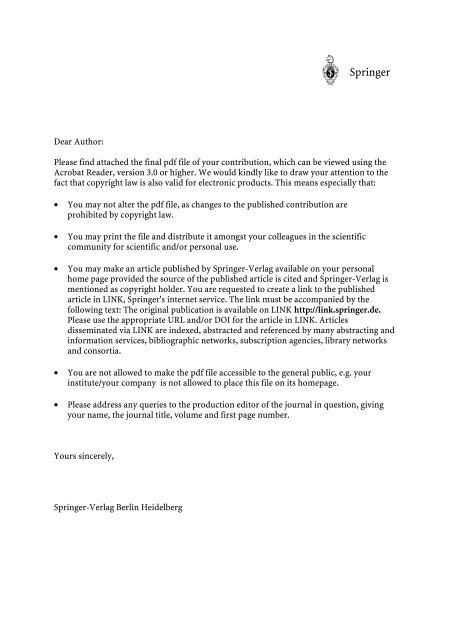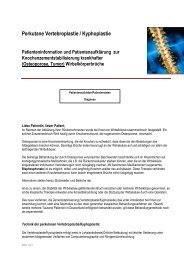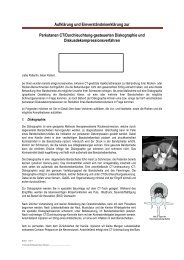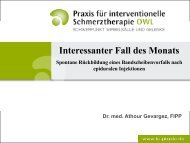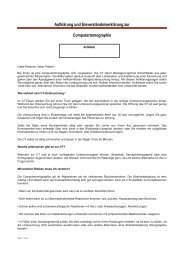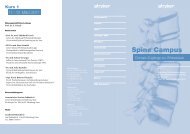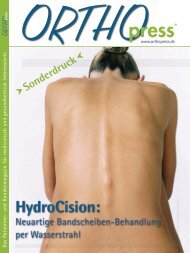6SULQJHU - Praxis für interventionelle Schmerztherapie OWL
6SULQJHU - Praxis für interventionelle Schmerztherapie OWL
6SULQJHU - Praxis für interventionelle Schmerztherapie OWL
You also want an ePaper? Increase the reach of your titles
YUMPU automatically turns print PDFs into web optimized ePapers that Google loves.
'HDU $XWKRU<br />
<strong>6SULQJHU</strong><br />
3OHDVH ILQG DWWD�KHG WKH ILQDO SGI ILOH RI \RXU �RQWULEXWLRQ ZKL�K �DQ EH YLHZHG XVLQJ WKH<br />
$�UREDW 5HDGHU YHUVLRQ RU KLJKHU :H ZRXOG NLQGO\ OLNH WR GUDZ \RXU DWWHQWLRQ WR WKH<br />
ID�W WKDW �RS\ULJKW ODZ LV DOVR YDOLG IRU HOH�WURQL� SURGX�WV 7KLV PHDQV HVSH�LDOO\ WKDW<br />
•
Eur Radiol (2002) 12:1360–1365<br />
DOI 10.1007/s00330-001-1257-2 MUSCULOSKELETAL<br />
A. Gevargez<br />
D. Groenemeyer<br />
S. Schirp<br />
M. Braun<br />
Received: 9 August 2001<br />
Revised: 22 October 2001<br />
Accepted: 14 November 2001<br />
Published online: 9 February 2002<br />
© Springer-Verlag 2002<br />
A. Gevargez (✉) · D. Groenemeyer<br />
S. Schirp · M. Braun<br />
Department of Radiology and Microtherapy,<br />
Groenemeyer Institut of Microtherapy,<br />
University of Witten/Herdecke,<br />
Universitätsstrasse 142, 44799 Bochum,<br />
Germany<br />
e-mail: gevargez@microtherapy.de<br />
Tel.: +49-234-9780200<br />
Fax: +49-234-9780210<br />
D. Groenemeyer<br />
EFMT Development and Research Center<br />
for Microtherapy,<br />
Universitätsstrasse 142, 44799 Bochum,<br />
Germany<br />
Introduction<br />
Low back pain (LBP) is a complex clinical phenomenon<br />
that is mostly conditioned upon a variety of factors. Pain<br />
can be reproduced in cases of spondylarthrosis in the facet<br />
joints and can be reduced with anesthetic and corticosteroid<br />
injections [1] or denervation using ethanol or radiofrequency<br />
heat, in connection with or after a course of physical<br />
therapy. The role of the sacroiliac joint (SIJ) in LBP has<br />
been frequently discussed in the past decade [3, 4, 5, 6, 7].<br />
Although there is no current standard criterion for SIJ-generated<br />
pain, positive image-guided diagnostic blocks [8]<br />
and clinical examination [9, 10, 11, 12] can indicate the<br />
need for specific SIJ treatment to reduce symptomatic pain<br />
that can be found in the lumbar spine, the gluteal region<br />
with radiation into the dorsal thigh, the popliteal space, the<br />
CT-guided percutaneous radiofrequency<br />
denervation of the sacroiliac joint<br />
Abstract Defining the origin of low<br />
back pain is a challenging task.<br />
Among a variety of factors the sacroiliac<br />
joint (SIJ) is a possible pain<br />
generator, although precise diagnosis<br />
is difficult. Joint blocks may reduce<br />
pain, but are, in cases, of only temporary<br />
effect. This study was conducted<br />
to evaluate CT-guided percutaneous<br />
radiofrequency denervation<br />
of the sacroiliac joint in patients with<br />
low back pain. The procedure was<br />
performed on 38 patients who only<br />
temporarily responded to CT-guided<br />
SIJ blocks. The denervation was carried<br />
out in the posterior interosseous<br />
sacroiliac ligaments and on the dorsal<br />
rami of the fifth spinal nerve. All<br />
interventions were carried out under<br />
CT guidance as out-patient therapies.<br />
Three months after the therapy,<br />
13 patients (34.2%) were completely<br />
free of pain. Twelve patients (31.6%)<br />
reported on a substantial pain reduction,<br />
7 patients (18.4%) had obtained<br />
a slight and 3 patients (7.9%) no<br />
pain reduction. The data of 3 patients<br />
(7.9%) was missing. There were no<br />
intra- or postoperative complications.<br />
Computed tomography-guided<br />
percutaneous radiofrequency denervation<br />
of the sacroiliac joint appears<br />
safe and effective. The procedure<br />
may be a useful therapeutic modality,<br />
especially in patients with chronic<br />
low back pain, who only temporarily<br />
respond to therapeutic blocks.<br />
Keywords Sacroiliac joint · Low<br />
back pain · Radiofrequency<br />
denervation<br />
groin, and even the dorsal lower leg [13]. Current SIJ treatments<br />
include anesthetic as well as corticosteroid injections<br />
and denervation with ethanol. In our experience, especially<br />
patients with advanced arthropathy and resistant,<br />
chronic LBP often just temporarily benefit from injections<br />
and SIJ denervation with ethanol does offer only limited<br />
precision. These facts have motivated us to search for an<br />
alternative, precise, and lasting therapy modality.<br />
Image-guided radiofrequency (RF) denervation is a<br />
reliable method of denervation in the cervical, thoracic,<br />
and lumbar spine [2, 14, 15]. Current flowing through<br />
the electrode generates heat in adjacent tissue based on<br />
its resistance or impedance, until the temperature of the<br />
probe and that of surrounding tissue reach equilibrium.<br />
This causes the desired lesion in a controllable size and<br />
enables a precise denervation.
The purpose of this prospective study was to evaluate<br />
the role of CT-guided RF denervation of the SIJ in the<br />
management of non-radicular LBP.<br />
Materials and methods<br />
Forty-three patients with resistant pain were included in a prospective<br />
observational study (22 women and 21 men; age range<br />
30–79 years, mean age 57.2 years). LBP was present for at least<br />
3 months. All patients complained about persistent LBP after one<br />
to two facet joint injections with local anesthetic, steroids, and<br />
adjacent ethanol denervation in levels L3/4, L4/5, and L5/S1. Although<br />
pain related to the facet joints was reduced, persistent<br />
LBP was localized in the SIJ area with radiation into the gluteal<br />
region, the dorsal thigh, the popliteal space, and occasionally the<br />
dorsal lower leg. Patients reported severe LBP during specific<br />
provocative maneuvers such as Patrick’s test and pressure application<br />
to the sacroiliac ligaments at the sacral sulcus in prone position.<br />
Consequently, all 43 patients underwent CT-guided diagnostic<br />
sacroiliac joint blocks with a mixture of 2 ml 0.5% bupivacaine,<br />
20 mg of methylprednisolon (Volon A), and 0.5 ml ionic contrast<br />
medium (Fig. 1). The SIJ injections were performed with the patient<br />
positioned prone. On the follow-up 2 weeks later, 38 patients<br />
reported a definite, but only temporary pain relief. They were<br />
scheduled for RF denervation of the SIJ after complete informed<br />
consent was obtained. Five patients did not feel any pain difference<br />
within the 2 weeks after the injections and were therefore not<br />
considered for the RF denervation. The remaining 38 participants<br />
met the requirements according to Table 1, which also presents the<br />
indications for a RF denervation of the SIJ.<br />
Radiofrequency denervation of the sacroiliac joint<br />
The CT-guided interventions were performed on an outpatient basis<br />
only. A total of 51 interventions were carried out on 38 patients.<br />
Thirteen patients were treated bilaterally and 25 patients received<br />
unilateral denervation. The patient was placed on the CT<br />
table in prone position. Following that was a short scout image of<br />
the pelvis. The SIJ was scanned with a section thickness of 3 mm<br />
and a table advancement of 3 mm, viewing in the bone window on<br />
a Somatom Plus 4 Volume Zoom CT (Siemens) or EBT (Imatron<br />
C-150XLP). For the therapy we used a 50-W radiofrequency generator<br />
(NEURO NSO, Leibinger GmbH, Freiburg, Germany).<br />
The denervation was carried out on two locations.<br />
Posterior interosseous sacroiliac ligaments<br />
The section position with the most suitable access to the posterior<br />
interosseous sacroiliac ligaments was set as the intervention position.<br />
The planning line was drawn on the monitor mediolateral in<br />
1361<br />
an extremely plane angle (approximately 40°) and marked accordingly<br />
on the patient’s skin. Then a neutral electrode was placed on<br />
the contralateral side, on a level with the RF denervation. After<br />
preceding skin disinfection, sterile covering, and local anesthesia,<br />
a 10- or 15-cm, 23-G insulated RF cannula with 5-mm uninsulated<br />
tip (Leibinger) was placed percutaneously in the target region as<br />
planned on the monitor. Two to three corrections were necessary<br />
until the cannula was in the desired position controlled by two<br />
5-mm axial CT scans after each correction. Once the cannula was<br />
securely positioned and after corresponding anesthesia with<br />
2–4 ml bupivacain 0.5%, we injected 3–5 ml 0.9% isoton saline<br />
for enhanced temperature spreading and to reduce local impedance.<br />
We then led the monopolar RF electrode into the insulated<br />
therapy cannula and started RF coagulation. Current temperature<br />
was measured by the cannula tip during the whole procedure. To<br />
produce an overlapping coagulation we used three steps with 90°C<br />
applied temperature. In each step we drew the set backwards approximately<br />
5 mm after 90 s of heat application (Fig. 2).<br />
The passage of sacral ala and transverse process<br />
of the vertebral body L5<br />
Table 1 Inclusion and exclusion criteria for radiofrequency denervation of the sacroiliac joint (SIJ)<br />
Inclusion criteria Exclusion criteria<br />
Fig. 1 Before the sacroiliac joint (SIJ) was blocked with bupivacaine<br />
and methylprednisolone, contrast medium was applied to ensure<br />
secure drug spread. In the CT image, needle and contrast medium<br />
are clearly visible (arrow)<br />
We then replaced the sound to the upper part of the junction sacral<br />
ala and transverse process of the segment L5/S1 to lesion the dor-<br />
Persistent, non-radicular back pain in the SIJ region after CT-guided Preceding, negative, CT-guided, intraligamentous neural<br />
facet joint denervation in at least two segments, L4/5 and L5/S1, blockade of the SIJ<br />
and possibly L3/4<br />
Preceding, positive, CT-guided intraligamentous neural blockade of the SIJ Hemorrhagic diathesis<br />
Chronic SIJ pain –
1362<br />
▲<br />
Fig. 3 The intraoperative CT image shows the radiofrequency set<br />
placed at the upper part of the junction sacral ala and transverse<br />
process of the segment L5/S1 to lesion the dorsal branches of the<br />
fifth spinal nerve. Hereby we aimed at denervating large portions<br />
of the proximal SIJ, which are innervated by these structures<br />
Table 2 The radiofrequency (RF) parameters. These parameters<br />
can be adjusted on the RF generator. The energy output was controlled<br />
automatically according to tissue impedance and the desired<br />
temperature to ensure a controlled RF temperature<br />
RF Energy Tissue Total average<br />
temperature output impedance coagulation time<br />
(°C) (W) (Ω) (min)<br />
90 1.8–7.3 145–240 7.2<br />
sal branches of the fifth spinal nerve, once again applying 90°C of<br />
heat for 90 s (Fig. 3).<br />
After the 30-min intervention, the patients were rested and<br />
monitored for approximately 2 h and finally discharged home.<br />
The treatment did not require narcosis or sedation but local anesthesia<br />
in the area of the puncture.<br />
All patients were treated with standardized coagulative parameters<br />
as described in Table 2.<br />
Subjective pain sensation was measured with the help of a patient<br />
questionnaire on the second, seventh, thirteenth and nineteenth<br />
day post intervention. In the questionnaire the patients were<br />
asked to report on their pain sensation after the therapy. They were<br />
asked to choose one of four options: 1=no pain; 2=substantial pain<br />
reduction; 3=slight pain reduction; and 4=no pain reduction.<br />
Fig. 2a–c A CT image of the cannula position. a At first, the cannula<br />
is placed in the ventral portion of the ligamentous SIJ compartment.<br />
b, c To produce an overlapping lesion, the system was<br />
drawn backward between each denervation. With this technique as<br />
much as possible of the accessible proximal portion of the SIJ was<br />
treated with radiofrequency heat
Fig. 4 Proportion of patients with successful therapies (at least a<br />
substantial pain reduction) at different follow-up times<br />
If “no pain” or “substantial pain reduction” were chosen, the<br />
treatment was considered to be successful.<br />
Results<br />
All 51 interventions were carried out without intra- or<br />
postoperative complications such as bleedings, sensorimotoric<br />
disorders, hematoma, septic sacroilitis, articular<br />
abscesses, or osteomyelitis. Seven patients reported<br />
postoperative pain of up to 5 days, which required additional<br />
CT-guided blocks with corticoids and local anesthesia<br />
in 2 cases.<br />
After 2 days, 27 patients (71%) were totally free of<br />
pain. Nine patients (23.7%3) reported a substantial pain<br />
reduction and 2 patients (5.3%) felt a slight pain reduction<br />
after the therapy.<br />
On the seventh postinterventional day 23 patients<br />
(60.5%) were free of pain, 10 patients (26.3%) had a<br />
substantial reduction, and 4 patients (10.6%) only a<br />
slight reduction of pain. The data of 1 patient (2.6%) was<br />
not available.<br />
One month after the intervention, 15 patients (39.5%)<br />
were pain free, 12 patients (31.6%) still had a substantial<br />
pain reduction, 7 patients (18.3%) a slight reduction, and<br />
2 patients (5.3%) no pain reduction. Here the data of<br />
2 patients (5.3%) was missing.<br />
On the last follow-up, 3 months after the therapy, the<br />
data of 3 patients (7.9%) was missing and 13 patients<br />
(34.2%) said that they still felt no pain. Twelve patients<br />
(31.6%) reported a substantial pain reduction, 7 patients<br />
(18.4%) a slight reduction, and 3 patients (7.9%) experienced<br />
no pain reduction 3 months after the RF denervation<br />
(see Fig. 4).<br />
Discussion<br />
Our findings indicate that CT-guided radiofrequency<br />
denervation of the SIJ may be an effective alternative to<br />
reduce LBP in patients who only temporarily respond to<br />
SIJ injections. Image-guided SIJ blocks with local anesthetic<br />
and corticosteroids are gaining in popularity to re-<br />
1363<br />
Fig. 5a, b Injecting a fluid medium into the SIJ may cause severe<br />
complications in cases of, for example, advanced degenerative<br />
processes. a Contrast medium leaking from the SIJ (arrow). In<br />
cases of ethanol injection this would possibly lead to peritonitis,<br />
involvement of the lumbar plexus, or tissue necrosis. b Contrast<br />
medium is missing the SIJ (arrow) during a check-up before a<br />
neural blockade. The application of drugs or alcohol could result<br />
in, for example, unwanted denervation such as S1 or S2 denervation<br />
and neuritis. The visualization of these incidents is an essential<br />
advantage of CT guidance in order to prevent severe complications<br />
duce pain in symptomatic patients. Maldjian et al. [16]<br />
report that image-guided injection of steroid compounds<br />
into the joint can give good and long-lasting results,<br />
which is contrary to our experience especially in the<br />
present study. One reason for this discrepancy may lie in<br />
the relatively high age of our participants which often results<br />
in advanced arthropathy and greater chronicity<br />
[17]. The injection of 96% ethanol is an effective method
1364<br />
for denervation but is often entailed with complications<br />
such as S1, S2, and S3 part-nerve denervation and neuritis<br />
which may cause lasting pain, especially in the SIJ<br />
with its special anatomical features (Fig. 5). These complications<br />
were not observed in RF denervation, which<br />
we found easier to control and more precise than the<br />
chemical option. RF heat does not cause intra- or periarticular<br />
scar formation and muscular, ligamentous as well<br />
as osseous structures of the motion segment remain unharmed<br />
due to the percutaneous technique. The thermic<br />
sterilization effect minimizes the risk of contamination<br />
during the intervention. With respect to the effectiveness<br />
in pain reduction, similar results were recently reported<br />
by Ferrante et al., who performed RF denervation in<br />
33 patients with sacroiliac joint syndrome [18].<br />
Under CT guidance instruments can be precisely<br />
placed within the target region and a controlled lesion<br />
can be caused, which is essential not only for the therapy<br />
outcome but also for the protection of nearby vessels and<br />
other neural structures [19, 36]. We consider CT guidance<br />
with or without external laser marker systems essential<br />
for the effectiveness and safety of interventional<br />
procedures, especially in complicated structures such as<br />
the SIJ, the spine, the hip joint, or for sympathectomies<br />
and diagnostic biopsies [19, 20, 21, 22]. Additional safety<br />
is achieved by the close communication with the nonsedated<br />
patient during the treatment.<br />
The role of the SIJ in the symptomatology of pain in<br />
the lower back, the pelvis, and the lower extremities is<br />
not exactly clear. Up to now the lack of valid diagnostic<br />
standards for SIJ-generated pain and dysfunction, respectively,<br />
is a limitation in present studies and published<br />
treatment results. Clinical examination methods of the<br />
SIJ, such as stress maneuver, and Patrick’s, Gaenslen’s,<br />
and Yeoman’s tests, or compression of the sacral alae on<br />
prone-positioned patients, can provoke SIJ pain but are<br />
considered to be very unspecific. Examinations with CT<br />
of the SIJ can display erosions of the joint surfaces or<br />
subchondral sclerosis of the iliac or sacral bones [23, 24].<br />
The normal anatomy of the joint, however, also features<br />
certain asymmetries of the cartilage thickness (thinner on<br />
the side of the iliac bone) as well as irregular cartilage<br />
References<br />
1. Bogduk N. (1995) The anatomical basis<br />
for spinal pain syndromes. J Manipulative<br />
Physiol Ther 18:603–605<br />
2. Dreyfuss P, Halbrook B, Pauza K,<br />
Joshi A, McLarty J, Bogduk N (2000)<br />
Efficacy and validity of radiofrequency<br />
neurotomy for chronic lumbar zygapophyseal<br />
joint pain. Spine<br />
25:1270–1277<br />
covering of the articular surface. These differences are<br />
more often found in men and lead in the long run to capsule<br />
thickening, rough cartilage surface, and the development<br />
of marginal osteophytes [25]; therefore, we consider<br />
the diagnostic value of CT in sacroiliac joint disease limited<br />
because of its low sensitivity and specificity. Several<br />
investigations on the role of the SIJ in lower back pain<br />
can be found in the literature. Various recent publications<br />
discuss the issue of image-guided diagnostic and therapeutic<br />
injections [26, 27, 28, 29, 30, 31], and numerous<br />
anatomic and clinical papers have shown that the SIJ is<br />
thoroughly innervated and the presence of nerves in SIJ<br />
tissues make the joint likely to be a source of lower back<br />
pain when exposed to abnormal loading, excessive movements,<br />
and inflammation. Several investigators have<br />
found excessive sensory innervation in the ligamentous<br />
SIJ structures [32, 33, 34, 35]. Currently, image-guided<br />
diagnostic blocks and clinical pain provocation tests seem<br />
to be the only means for confirming sacroiliac origin of<br />
pain. In this study the therapeutic facet joint blocks allowed<br />
additional examination of the SIJ and helped to<br />
specify its role in LBP symptomatology. Another reason<br />
for back pain in the SIJ region can be the myofascial syndrome<br />
of the sacrospinal muscles; therefore, it is suggested<br />
to infiltrate this group of muscles with local anesthesia,<br />
before the SIJ is blocked.<br />
Conclusion<br />
3. Vleeming A, Pool-Goudzwaard AL,<br />
Hammudoghlu D, Stoeckart R,<br />
Snijders CJ, Mens JM (1996) The function<br />
of the long dorsal sacroiliac ligament:<br />
its implication for understanding<br />
low back pain. Spine 21:556–562<br />
4. Daum WJ (1995) The sacroiliac joint:<br />
an underappreciated pain generator.<br />
Am J Orthop 24:475–478<br />
5. Swezey RL (1998) The sacroiliac joint.<br />
Nothing is sacred. Phys Med Rehabil<br />
Clin North Am 9:515–519<br />
In conclusion, we describe CT-guided radiofrequency<br />
denervation of the SIJ joint as a new, minimally invasive<br />
technique that appears safe and effective. This method<br />
may be a useful therapeutic modality, especially in patients<br />
with chronic low back pain, who only temporarily<br />
respond to therapeutic blocks. Controlled, randomized<br />
investigations with greater sample size over a longer period<br />
of time will be necessary to judge this technique<br />
more closely. Since chronic low back pain is such an intricate<br />
clinical phenomenon, we consider a far-reaching<br />
multi-disciplinary cooperation as the basis of more patient<br />
comfort, cost efficacy, and better therapy results.<br />
6. Cibulka MT, Koldehoff R (1999) Clinical<br />
usefulness of a cluster of sacroiliac<br />
joint tests in patients with and without<br />
low back pain. J Orthop Sports Phys<br />
Ther 29:83–89<br />
7. Slipman CW, Sterenfeld EB, Chou LH,<br />
Herzog R, Vresilovic E (1998) The<br />
predictive value of provocative sacroiliac<br />
joint stress maneuvers in the diagnosis<br />
of sacroiliac joint syndrome.<br />
Arch Phys Med Rehabil 79:288–292
8. Schwarzer AC, Aprill CN, Bogduk N<br />
(1995) The sacroiliac joint in chronic<br />
low back pain. Spine 20:31–37<br />
9. Broadhurst NA, Bond MJ (1998) Pain<br />
provocation tests for the assessment of<br />
sacroiliac joint dysfunction. J Spinal<br />
Disord 11:341–345<br />
10. Fortin JD, Falco FJ (1997) The fortin<br />
finger test: an indicator of sacroiliac<br />
pain. Am J Orthop 26:477–480<br />
11. Croft PR, Macfarlane GJ,<br />
Papageorgiou AC, Thomas E, Silman<br />
AJ (1998) Outcome of low back pain<br />
in general practice: a prospective study.<br />
Br Med J 316:1356–1359<br />
12. Fortin JD, Dwyer AP, West S, Pier J<br />
(1994) Sacroiliac joint: pain referral<br />
maps upon applying a new injection/arthrography<br />
technique. Part I: Asymptomatic<br />
volunteers. Spine<br />
19:1475–1482<br />
13. Slipman CW, Jackson HB, Lipetz JS,<br />
Chan KT, Lenrow D, Vresilovic EJ<br />
(2000) Sacroiliac joint pain referral<br />
zones. Arch Phys Med Rehabil<br />
81:334–338<br />
14. Bogduk N, Macintosh J, Marsland<br />
(1987) A technical limitation to the efficacy<br />
of radiofrequency neurotomy for<br />
spinal pain. Neurosurgery 20:529–535<br />
15. Gevargez A, Braun M, Schirp S,<br />
Weinsheimer PA, Groenemeyer DHW<br />
(2001) Chronic non radicular cervicocephalic<br />
syndrome: CT-guided percutaneous<br />
RF-thermocoagulation of the<br />
cervical zygapophysial joints.<br />
Der Schmerz 15:186–191<br />
16. Maldjian C, Mesgarzadeh M,<br />
Tehranzadeh J (1998) Diagnostic and<br />
therapeutic features of facet and sacroiliac<br />
joint injection. Anatomy, pathophysiology<br />
and technique. Radiol Clin<br />
North Am 36:497–508<br />
17. Kampen WU, Tillmann B (1998) Agerelated<br />
changes in the articular cartilage<br />
of human sacroiliac joint. Anat<br />
Embryol (Berl) 198:505–513<br />
18. Ferrante MF, King LF, Roche EA,<br />
Kim, PS, Aranda M, DeLaney LR,<br />
Mardini IA, Mannes AJ (2001) Radiofrequency<br />
sacroiliac joint denervation<br />
for sacroiliac syndrome. Reg Anesth<br />
Pain Med 26:137–142<br />
19. Gevargez A, Groenemeyer DHW,<br />
Czerwinski F (2000) CT-guided percutaneous<br />
laser disc decompression with<br />
Ceralas D, a diode laser with 980-nm<br />
wavelength and 200-micron fiber optics.<br />
Eur Radiol 10:1239–1241<br />
20. Kloeppel R, Weisse T, Deckert F,<br />
Wilke W, Pecher S (2000) CT-guided<br />
intervention using a patient laser marker<br />
system. Eur Radiol 10:1010–1014<br />
21. Heywang-Kobrunner SH, Amaya B,<br />
Okoniewski M, Pickuth D, Spielmann<br />
RP (2001) CT-guided obturator nerve<br />
block for diagnosis and treatment of<br />
painful conditions of the hip.<br />
Eur Radiol 11:1047–1053<br />
22. Grönemeyer D, Seibel R (1989) Interventionelle<br />
Computertomographie.<br />
Ueberreuter Wissenschaft, Berlin<br />
23. Damilakis J, Prassopoulos P,<br />
Perisinakis K, Faflia C, Gourtsoyiannis<br />
N (1997) CT of the sacroiliac joints.<br />
Dosimetry and optimal settings for a<br />
high-resolution technique. Acta Radiol<br />
38:870–875<br />
24. Elgafy H, Semaan HB, Ebraheim NA,<br />
Coombs RJ (2001) Computed tomography<br />
findings in patients with sacroiliac<br />
pain. Clin Orthop:112–118<br />
25. Bowen V, Cassidy JD (1981) Macroscopic<br />
and microscopic anatomy of the<br />
sacroiliac joint from embryonic life until<br />
the eighth decade. Spine 6:620–628<br />
26. Bollow M, Braun J, Taupitz M,<br />
Haberle J, Reibhauer BH, Paris S,<br />
Mutze S, Seyrekbasan F, Wolf KJ,<br />
Hamm B (1996) CT-guided intraarticular<br />
corticosteroid injection into the sacroiliac<br />
joints in patients with spondyloarthropathy:<br />
indication and follow-up<br />
with contrast-enhanced MRI. J Comput<br />
Assist Tomogr 20:512–521<br />
1365<br />
27. Rosenberg JM, Quint TJ, de Rosayro<br />
AM (2000) Computerized tomographic<br />
localization of clinically-guided sacroiliac<br />
joint injections. Clin J Pain<br />
16:18–21<br />
28. Maugars Y, Mathis C, Berthelot JM,<br />
Charlier C, Prost A (1996) Assessment<br />
of the efficacy of sacroiliac corticosteroid<br />
injections in spondylarthropathies:<br />
a double-blind study. Br J Rheumatol<br />
35:767–770<br />
29. Pulisetti D, Ebraheim NA (1999)<br />
CT-guided sacroiliac joint injections.<br />
J Spinal Disord 12:310–312<br />
30. Dussault RG, Kaplan PA, Anderson<br />
MW (2000) Fluoroscopy-guided sacroiliac<br />
joint injections. Radiology<br />
214:273–277<br />
31. Lippitt A (1995) Recurrent subluxation<br />
of the sacroiliac joint: diagnosis and<br />
treatment. Bull Hosp Joint Dis<br />
54:94–102<br />
32. Fortin JD, Kissling RO, O’Connor BL,<br />
Vilensky JA (1999) Sacroiliac joint innervation<br />
and pain. Am J Orthop<br />
28:687–690<br />
33. Ikeda R (1991) Innervation of the sacroiliac<br />
joint. Macroscopic and histological<br />
studies. Nippon Ika Daigaku<br />
Zasshi 58:587–596<br />
34. Grob KR, Neuhuber WL, Kissling RO<br />
(1995) Innervation of the sacroiliac<br />
joint of the human. Z Rheumatol<br />
54:117–122<br />
35. Ebraheim NA, Lu J, Biyani A,<br />
Huntoon M, Yeasting RA (1997) The<br />
relationship of lumbosacral plexus to<br />
the sacrum and the sacroiliac joint. Am<br />
J Orthop 26:105–110<br />
36. Groenemeyer D, Seibel R, Melzer A,<br />
Schmidt A (1995) Image-guided<br />
Access Techniques. End Surg 3:69–75


